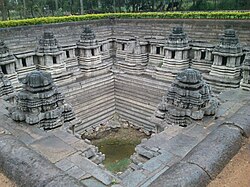Hulikere
| Hulikere | ||
|---|---|---|
|
|
||
| State : |
|
|
| State : | Karnataka | |
| District : | Hassan | |
| Location : | 13 ° 12 ' N , 76 ° 0' E | |
| Height : | 880 m | |
| Residents : | 300 (2011) | |
| Hulikere - stepwell ( kalyani ) | ||
Hulikere is a village with approx. 300 inhabitants in the municipality ( taluk ) of Halebidu in the Hassan district in the southwest Indian state of Karnataka . The place is known for a step well ( kalyani or tank ) from the Hoysala period.
location
Hulikere lies on the Dekkan Plateau at an altitude of approx. 880 m above sea level. d. M. almost 30 km (driving distance) northwest of the district capital Hassan or about 1 km south of Halebid . Because of the altitude, the climate is rather moderate by Indian standards; Rain falls mainly during the monsoon months June to October.
population
The rural population, mostly speaking Kannada , consists almost without exception of Hindus ; Muslims and other religions are numerically small minorities. The male and female proportions of the population are roughly the same.
economy
The residents of Kulikere live largely as farmers - while in earlier times they were almost exclusively self-sufficient, with the improvement of transport options, other sales markets have also been added. The fields in the area mainly grow wheat , lentils and vegetables. Even coconut trees play an important role in the economy of the region.
history
In the Middle Ages, Hulikere was a suburb of Dorasamudra , the then capital of the Hoysala Empire. In the 15th and first half of the 16th century, the area was part of the Vijayanagar Empire, in 1690 it came under the control of the princely state of Mysore , whose rule, however, in the second half of the 18th century by Hyder Ali (r . 1761–1782) and his son Tipu Sultan (r. 1782–1799) was interrupted. The British later played the dominant military and economic role in South India.
Attractions
The only attraction of Hulikere is a square stepwell ( kalyani or tank ) about 15 m deep, which was built in the immediate vicinity of a Shiva temple around 1160 under King Narasimha I (reigned 1152–1173). While the temple has completely disappeared over time, the imposing stepwell, on the sides of which there are numerous small shrines, 12 of which have 'umbrella domes' as the top, has survived the course of time.
- Surroundings
- Approx. 1 km north is the Halebidu temple precinct .
- Approx. 16 km to the south is the village of Doddagaddavalli with the Lakshmi Devi temple arranged in the shape of a shamrock ( trikuta ) .
literature
- Gerard Foekema: Hoysala Architecture: Medieval Temples of Southern Karnataka built during Hoysala Rule. Books & Books, New Delhi 1994, ISBN 978-81-8501-641-2 .
- Gerard Foekema: Complete Guide to Hoysala Temples. Abhinav Publ., New Delhi 1996, ISBN 81-7017-345-0 .
- S. Settar: The Hoysala Temples. Kala Yatra Publ., Bangalore 1992, ISBN 978-81-9001-721-3 .
Web links
- Hulikere, Stepwell - Photos + Brief Information ( ASI , English)

